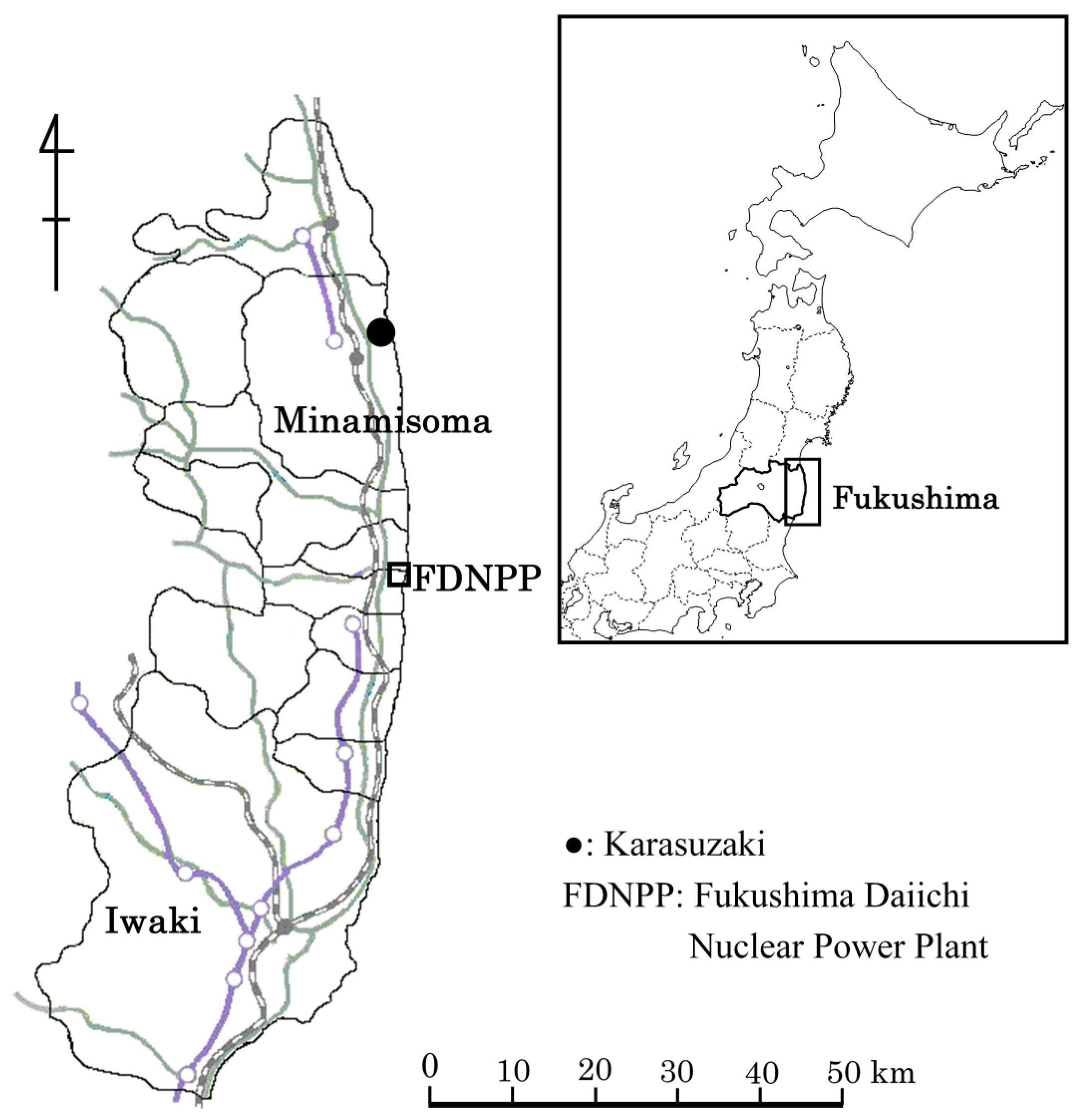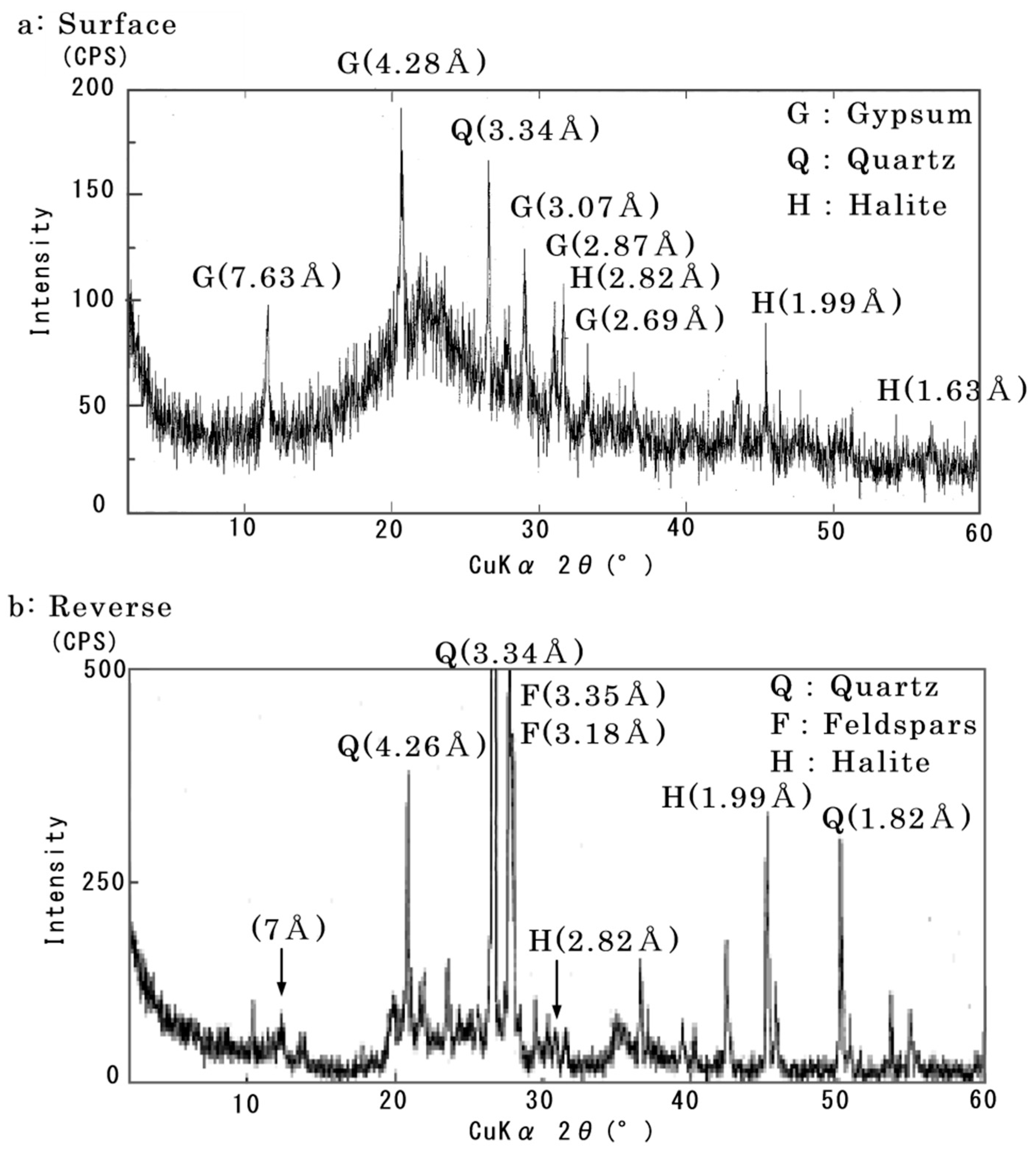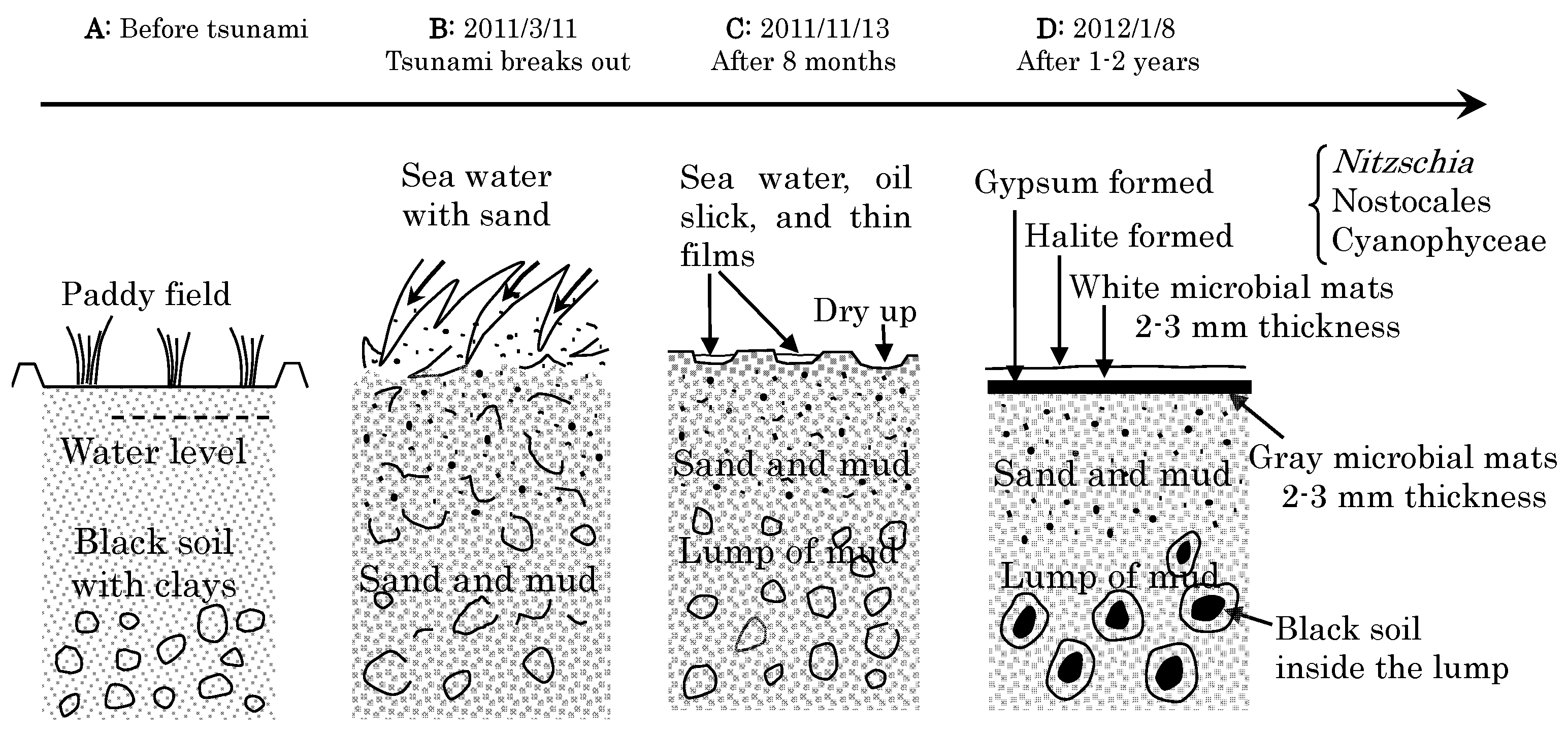Formation of Microbial Mats and Salt in Radioactive Paddy Soils in Fukushima, Japan
Abstract
:1. Introduction


2. Materials and Methods
2.1. Investigated Specimens
2.2. X-Ray Diffraction
2.3. ED-XRF Chemical Analyses
2.4. Ge Semiconductor Analysis
2.5. Scanning Electron Microscopy (SEM) Equipped with Energy Dispersive Spectroscopy (EDS)
3. Results
3.1. Mineralogy of the Microbial Mats

3.2. Chemical Composition of the Microbial Mats
| Element | Samples | |||||
|---|---|---|---|---|---|---|
| No.1 | No.2 | No.3 | No.4 | No.5 | No.6 | |
| Na | 2.64 | 2.57 | 2.39 | 2.44 | 2.31 | 2.41 |
| Mg | 3.52 | 3.51 | 2.44 | 2.19 | 2.76 | 2.66 |
| Al | 15.5 | 14.9 | 16.9 | 17.7 | 17.4 | 17 |
| Si | 33.5 | 32 | 35.7 | 42.8 | 37.2 | 34.9 |
| P | 0.721 | 0.676 | 0.421 | 0.35 | 0.467 | 0.417 |
| S | 1.76 | 1.79 | 1.64 | 0.931 | 1.98 | 1.95 |
| Cl | 5.91 | 6.85 | 6.38 | 4.45 | 5.08 | 5.89 |
| K | 2.12 | 2.26 | 2.54 | 2.96 | 2.65 | 2.73 |
| Ca | 3.56 | 4.26 | 2.66 | 4.39 | 3.8 | 2.65 |
| Ti | 0.767 | 0.881 | 1.08 | 2.65 | 1.63 | 1.23 |
| Mn | 0.842 | 0.653 | 0.279 | 0.337 | 0.439 | 0.344 |
| Fe | 8.87 | 10.1 | 11.3 | 13.2 | 14.3 | 13.1 |
| Cr | 0.0233 | 0.0255 | 0.0313 | 0.068 | 0.0422 | 0.0331 |
| Ni | 0.0117 | 0.0135 | 0.0174 | 0.0159 | 0.0215 | 0.0203 |
| Cu | 0.0149 | N.D. | 0.0192 | 0.0138 | 0.0243 | 0.0198 |
| Zn | 0.0416 | 0.0461 | 0.0461 | 0.0423 | 0.0597 | 0.0609 |
| Br | 0.0508 | 0.0588 | 0.0492 | 0.0177 | 0.0453 | 0.0533 |
| Rb | 0.0166 | 0.0176 | 0.0186 | 0.0148 | 0.0223 | 0.0232 |
| Sr | 0.048 | 0.0545 | 0.0449 | 0.0522 | 0.059 | 0.0571 |
| Zr | N.D. | N.D. | 0.043 | 0.0906 | N.D. | N.D. |
| Ba | 0.0335 | 0.039 | 0.0524 | 0.0609 | 0.0513 | 0.0559 |
| Total | 79.9504 | 80.705 | 83.9997 | 94.7742 | 90.3416 | 85.6046 |
| Heated at 600 °C | 20.1 | 19.3 | 15.9 | 5.2 | 9.6 | 14.4 |
3.3. Radionuclides in the Microbial Mats and Solar Salts (Table 2)
| Radionuclide | Microbial Mats | Paddy Soils | |||||||
|---|---|---|---|---|---|---|---|---|---|
| No.1 | No.2 | No.3 | No.4 | No.5 | No.6 | No.7 | |||
| 131I | N.D. | N.D. | N.D. | N.D. | N.D. | N.D. | N.D. | ||
| 40K | N.D. | 460 | N.D. | 370 | N.D. | N.D. | N.D. | ||
| 134Cs | 2200 | 2000 | 2500 | 1900 | 2300 | 2600 | 19,000 | ||
| 137Cs | 4200 | 4300 | 5500 | 4000 | 4700 | 6000 | 27,000 | ||
| 134Cs/137Cs | 0.52 | 0.47 | 0.45 | 0.48 | 0.49 | 0.43 | 0.7 | ||
| Hydrate (%) | 26.3 | 25.5 | 25 | 7 | 39.9 | 39.6 | 16.8 | ||
| Analyzed date | 5 June 2013 | 3 July 2012 | |||||||
| Radionuclide in Solar Salts | Dose Rate | ||||||||
| 131I | N.D. | N.D. | N.D. | ||||||
| 40K | 369 | 304.2 | 344.35 | ||||||
| 134Cs | 4.75 | 25.3 | 2.3 | ||||||
| 137Cs | 31.77 | 106.25 | 28.3 | ||||||
| 134Cs/137Cs | 0.15 | 0.24 | 0.08 | ||||||
| Analyzed date | 22 April 2015 | 14 May 2015 | 7 June 2015 | ||||||
3.4. SEM-EDS Analysis of Microbial Mats and Solar Salt

| Elements and Spectrum | Microbial Mats Analytical Point | Solar Salt | |||||
|---|---|---|---|---|---|---|---|
| Point 1 | Point 2 | Point 3 | Point 4 | Point 5 | 23 June 2015 | ||
| Mg | Kα1 | 3.03 | 2.12 | 2.06 | 1.65 | 2.66 | 4.71 |
| Al | Kα1 | 1.28 | 6.1 | 3.13 | 6.66 | 7.49 | 0 |
| Si | Kα1 | 19.45 | 26.62 | 28.08 | 27.27 | 17.19 | 0 |
| S | Kα1 | 2.95 | 0.51 | 2.02 | 0.81 | 0.35 | 1.71 |
| Cl | Kα1 | 9.05 | 2.32 | 6.58 | 3.58 | 6.95 | 14.53 |
| K | Kα1 | 0.47 | 1.59 | 0.56 | 1.14 | 1.98 | 0.86 |
| Ca | Kα1 | 1.57 | 0.7 | 1.13 | 1.15 | 0.7 | 0.07 |
| Mn | Kα1 | 0 | 0.15 | 0.13 | 0.12 | 0.14 | 0 |
| Fe | Kα1 | 2 | 11.16 | 2.73 | 5.92 | 11.01 | 0 |
| Ni | Kα1 | # | # | # | # | # | 0.02 |
| As | Kα1 | # | # | # | # | # | 0.02 |
| Zr | Kα1 | # | # | # | # | # | 4.33 |
| Sn | Kα1 | # | # | # | # | # | 0.02 |
| Zn | Lα1 | 9.97 | 2.04 | 7.31 | 4.67 | 9.58 | # |
| I | Lα1 | 0.19 | 0.18 | 0.08 | 0.13 | 0.23 | 0 |
| Cs | Lα1 | 0 | 0 | 0 | 0.14 | 0.33 | 0.01 |
| Ba | Lα1 | 0.23 | 0.92 | 0 | 0.76 | 2.37 | 0.01 |
| Nd | Lα1 | 0 | 0.12 | 0.13 | 0.1 | 0.09 | # |
| Th | Mα | 2.05 | 1.63 | 2.05 | 1.63 | 2.1 | # |
| U | Mα | 0.15 | 0.02 | 0.17 | 0.14 | 0 | # |
| Np | Mα | 0.93 | 1.01 | 1 | 0.78 | 1.26 | # |
| O | # | 43.22 | 42.79 | 42.83 | 43.35 | 35.56 | 29.58 |
| Content | Figure 4a | Figure 4b | # | Figure 4c | # | Figure 4d | |
| Diatom | Diatom | Diatom | Diatom | Diatom | # | ||
| Coccus B. | Clays | Coccus B. | Clays | Clays | # | ||
| Salt | Salt, Gypsum | Filament | Salt | Salt | Salt crystal | ||
3.5. Formation Processes of Microbial Mats on the Paddy Field after the FDNPP Accident

4. Discussion
4.1. Bio-Mineralization and Bio-Remediation
4.2. Source of Zirconium in the Microbial Mats and Salts
4.3. Radionuclide Sorption to Clays and Salt in Microbial Mats
5. Concluding Remarks
- (1)
- This study is probably the first one to identify materials that can strongly absorb and retain radioactive elements in the actual paddy soils in Fukushima. The results suggest that microorganisms living in colonies constructed biofilms and microbial mats on the surface of paddy soils after the FDNPP accident and tsunami.
- (2)
- Microorganisms responded with a metabolic reaction under radioactive and salty conditions, forming gypsum and halite showing the ability of microorganisms to grow in this contaminated environment and to immobilize radionuclides.
- (3)
- The microorganisms inhabit each growing environment selectively forming microbial mats and t concentrate particular elements, such as radionuclides with salt.
- (4)
- The solar salt made of sea water at Karasuzaki ocean bath, Minami-soma City, Fukushima, in 2015, shows a high Zr (4.33%) content associated with 137Cs and 40K without 131I. The microbial mats have also accumulated Zr after the FDNPP accident and tsunami.
- (5)
- It is possible that the capability of radioactive immobilization can be used to counteract the disastrous effects of radionuclide-polluted paddy soils.
- (6)
- Their presence in the environment, therefore, is of use for mediating the risk of contaminated sites for longer periods of time, such as concentration of 90Sr and 93, 94, 96Zr on many different spatial and time scales and would benefit our global society.
Acknowledgments
Author Contributions
Conflicts of Interest
References
- The Japan Times: Evacues from Tree Municipalities in Fukushima Pref. Available online: http://japan.kantei.go.jp/kan/topics/201106/pdf/attach_04_2.pdf2011 (accessed on 2 September 2015).
- Atomic Energy Safety Agent: Results of Emitted Radionuclide Examination on 6 June 2011. Available online: http://japan.kantei.go.jp/kan/topics/201106/pdf/attach_04_2.pdf (accessed on 23 November 2015).
- Tazaki, K.; Takehara, T.; Ishigaki, Y.; Nakagawa, H.; Okuno, M. SEM-EDX observation of diatomaceous earth at radioactive paddy soils in Fukushima, Japan. In Geotherapy; CRC Press: Boca Raton, FL, USA; Taylor & Francis Group: Abingdon, UK, 2015; pp. 521–544. [Google Scholar]
- Shimojima, Y.; Kato, T.; Ohtomo, Y.; Okuno, M.; Tazaki, K. Characteristics of Microbial Mats in Fukushima Prefecture, after the Pacific Coast of Tohoku Earthquake on 11 March 2011. Kahokugata Lake Sci. 2015, 18, 43–55. [Google Scholar]
- JEOL Ltd. Application Data of JSX-1000s, Element Eye; JEOL Ltd.: Tokyo, Japan, 2015; p. 5. [Google Scholar]
- Tamura, K.; Kogure, T.; Watanabe, Y.; Nagai, C.; Yamada, H. Uptake of cesium and strontium ions by artificially altered phlogopite. Environ. Sci. Technol. 2014, 48, 5808–5815. [Google Scholar] [CrossRef] [PubMed]
- Kogure, T. Clay minerals sorbing radiocesium in Fukushima: Investigation by IP autoradiography and electron microscopy. Nendo Kagaku 2015, 54, 22–27. [Google Scholar]
- Staley, J.T. Microbial mats matter as marvelous manifestations of life. In Microbial Mats: Modern and Ancient Microorganisms in Stratified Systems; Springer: Berlin, Geramny, 2010. [Google Scholar]
- Eriksson, P.G.; Sarkar, S.; Samanta, P.; Banerjee, S.; Porada, H.; Catuneanu, O. Paleoenvironmental context of microbial mat-related structures in siliciclastic rocks. In Microbial Mats: Modern and Ancient Microorganisms in Stratified Systems; Springer: Berlin, Geramny, 2010; pp. 73–108. [Google Scholar]
- Paterson, D.M.; Aspden, R.J.; Pamelareid, R. Biodynamics of modern marin stromatolites. In Microbial Mats: Modern and Ancient Microorganisms in Stratified Systems; Springer: Berlin, Geramny, 2010; pp. 225–235. [Google Scholar]
- Underwood, G.J.C. Exopolymers (Extracellular polymeric substances) in diatom-dominated marine sediment biofilms. In Microbial Mats: Modern and Ancient Microorganisms in Stratified Systems; Springer: Berlin, Geramny, 2010; pp. 289–300. [Google Scholar]
- Seckbach, J.; Oren, A. (Eds.) Microbial Mats: Modern and Ancient Microorganisms in Stratified Systems; Springer: Berlin, Geramny, 2010; p. 606.
- Simkiss, K.; Wilbur, K.M. Biomineralization: Cell Biology and Mineral Deposition; Academic Press, Inc.: Waltham, MA, USA, 1989; p. 337. [Google Scholar]
- Sakurai, H.; Ogawa, T.; Shiga, M.; Inoue, K. Inorganic sulfur oxidizing system in green sulfur bacteria. Photosynth. Res. 2010, 104, 163–176. [Google Scholar] [CrossRef] [PubMed]
- Tazaki, K.; Okuno, M.; Shiraishi, S. Deep subterranean and surface life system research: Focusing particularly on hot spring biomats. In Past, Present and Future Environments of Pan-Japan Sea Region; Hayakawa, K., Ed.; Maruzen Co. Ltd.: Osaka, Japan, 2006; pp. 460–481. [Google Scholar]
- Nishio, B. History of Atomic Nuclear Power Radiation Accidents in the World; Nanatsumori Publisher: Tokyo, Japan, 2015; p. 330. [Google Scholar]
- NHK Newsweb. 2015. Available online: http://enenews.com/nuclear-fuel-found-15-miles-tokyo-suburbs-fukushima-uranium-glassy-spheres-transported-170-km-structural-materials-nuclear-reactors-present-photos (accessed on 23 November 2015).
- Cornell, R.M. Adsorption of cesium on minerals: A review. J. Radioanal. Nucl. Chem. 1993, 171, 483–500. [Google Scholar] [CrossRef]
- Mckinley, J.P.; Zachara, J.M.; Heald, S.M.; Dohnalkova, A.; Newville, N.G.; Sutton, S.R. Microscale distribution of cesium sorbed to biotite and muscovite. Environ. Sci. Technol. 2004, 38, 1017–1023. [Google Scholar] [CrossRef] [PubMed]
- Kogure, T.; Morimoto, K.; Tamura, K.; Sato, H.; Yamagishi, A. XRD and HRTEM evidence for fixation of cesium ions in vermiculite clays. Chem. Lett. 2012, 41, 380–382. [Google Scholar] [CrossRef]
- Cygan, R.T.; Tazaki, K. Toward understanding interactions of kaolin minerals in the environment. Elements 2014, 10, 195–200. [Google Scholar] [CrossRef]
- Fujii, E.; Tamura, K.; Hatta, T.; Yamada, H.; Yaita, T.; Kogure, T. Cesium sorption to paddy soil in Fukushima. Clay Sci. 2015, 19, 17–22. [Google Scholar]
- Komuro, K.; Inoue, M.; Murata, Y.; Manikandan, N.M. Variation of radionuclides in the atmosphere, rainwater, and seawater in the Northwest Pacific region. In Past, Present and future environments of Pan-Japan Sea Region; Hayakawa, K., Ed.; Maruzen Co. Ltd.: Osaka, Japan, 2006; Volume 8, pp. 272–291. [Google Scholar]
© 2015 by the authors; licensee MDPI, Basel, Switzerland. This article is an open access article distributed under the terms and conditions of the Creative Commons by Attribution (CC-BY) license (http://creativecommons.org/licenses/by/4.0/).
Share and Cite
Tazaki, K.; Shimojima, Y.; Takehara, T.; Nakano, M. Formation of Microbial Mats and Salt in Radioactive Paddy Soils in Fukushima, Japan. Minerals 2015, 5, 849-862. https://doi.org/10.3390/min5040529
Tazaki K, Shimojima Y, Takehara T, Nakano M. Formation of Microbial Mats and Salt in Radioactive Paddy Soils in Fukushima, Japan. Minerals. 2015; 5(4):849-862. https://doi.org/10.3390/min5040529
Chicago/Turabian StyleTazaki, Kazue, Yasuhiro Shimojima, Teruaki Takehara, and Mikio Nakano. 2015. "Formation of Microbial Mats and Salt in Radioactive Paddy Soils in Fukushima, Japan" Minerals 5, no. 4: 849-862. https://doi.org/10.3390/min5040529





